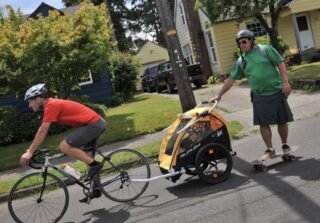
(Photos by J. Maus/BikePortland)
As Portland’s transportation thinkers look to a new post-pandemic mobility paradigm, there’s one type of vehicle that just can’t seem to break into the conversation: skateboards.
Despite sharing many of the same benefits as bicycling and walking, there are no skateboard advocates on the city’s various modal committees. PBOT has advisory committees devoted to bicycle users, walkers, wheelchair users and freight haulers — and none of them include a voice for skateboarding. As vulnerable road users that fight for space on the roadways and often face hostility from other road users (as we saw Wednesday when a skateboarder was killed after being allegedly run over by a driver in a Vancouver, Washington parking lot), a skateboarding advocate thinks it’s time to embrace this form of transportation.
Cory Poole is Portland’s most outspoken skateboard and “push scooter” advocate. He launched the NW Skate Coalition in 2013 and has pushed to get several issues on PBOT’s radar in the years since. These days he’s frustrated that despite his best efforts, he’s still on the outside looking in. I caught up with him recently to learn about what issues he’s concerned about and why he sees so many parallels between the needs of people who bike bike and those who skate.
Advertisement
Poole is well-known among Portland’s transportation advocacy scene because he always shows up to support bicycling and walking. He’s also an eager participant in events where he’s often the only one on a board, like when he made very impressive showings at the Ladds 500 and Disaster Relief Trials (where he pulled a cargo trailer!).
One of the main issues Poole is worried about is the county’s project to replace the Burnside Bridge. “That proposal went through the PAC and BAC [pedestrian and bicycle advisory committees] and issues important to skaters like expansion joints, surface grooves, and most importantly the possible destruction of the famous Burnside skate park weren’t even addressed.”
(Photo: Cory Poole)
(Photo: Cory Poole)
Even bicycle riders can relate to the harsh and sometimes scary feeling of riding over expansion joints and other bumps in our infrastructure. There are big ones gaps on the Tilikum and St. Johns Bridges, and bumps on the floating docks of the Eastbank Esplanade have caused many crashes and lost or damaged equipment over the years.
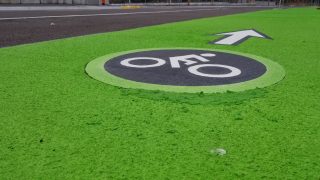
(Photo by Cory Poole)
Another big problem Poole sees as being directly related to bicycling is the green thermoplastic being installed in bikeways around the city. He said he first flagged the issue for PBOT in 2018 when green lanes were installed around the Tilikum Bridge. “The green was applied so rough that it forced skateboarders into the street or pedestrian path,” Poole shared with us recently. Poole claims he was told by PBOT that a new, smoother treatment (like the paint used on SW Oak Street) would be the norm; but he’s seen several implementations of the rough thermoplastic since then. “I’m very concerned that the new green lane being planned for Better Naito will be completely unusable for skateboards and push scooters,” Poole said.
Advertisement
Poole has applied to be a member of PBOT’s pedestrian and bicycle committees, but much to his chagrin has never been selected.
“The BAC and PAC are the primary mechanisms that the city of Portland uses to address infrastructure design and implementation,” Poole said. “Given that thousands of Portlanders use skateboarders and scoots to get to work, school and play it seems reasonable that we should have at least one representative in one of the committees with a vote at the table. I don’t want to take anything away from either of these bodies because I’m a passionate supporter of bicycle and pedestrian transportation, we need an opportunity to make our concerns known in a way that we know that we won’t simply be ignored.”
The COVID-19 pandemic has forced a massive shift in thinking when it comes to how we get around. Let’s hope that shift includes more open minds to skateboarding and small but important changes to our infrastructure that will support it.
— Jonathan Maus: (503) 706-8804, @jonathan_maus on Twitter and jonathan@bikeportland.org
— Get our headlines delivered to your inbox.
— Support this independent community media outlet with a one-time contribution or monthly subscription.



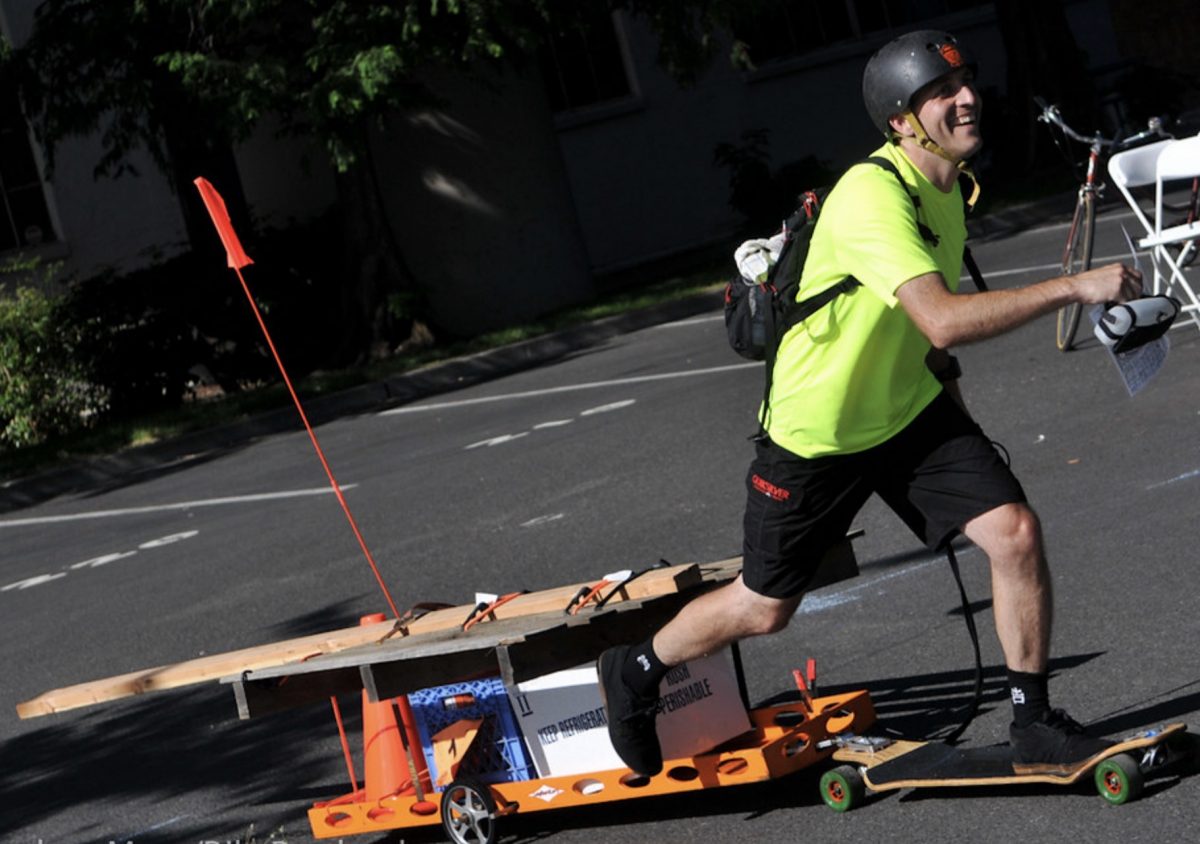
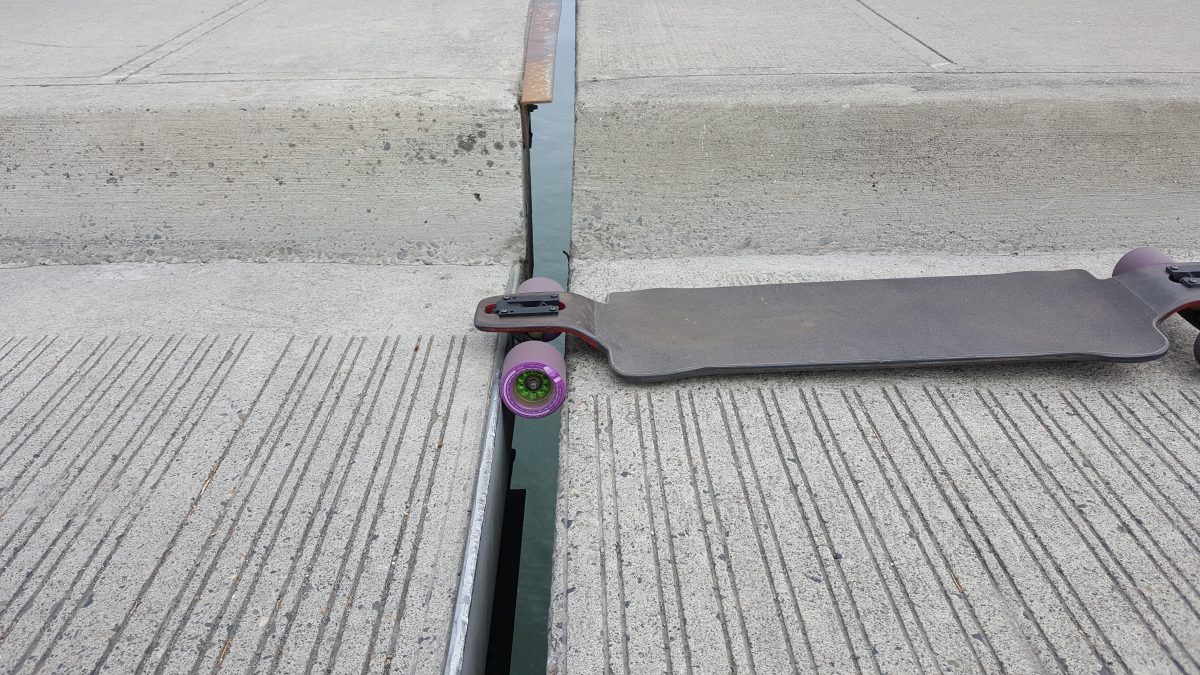

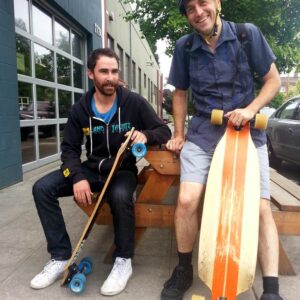
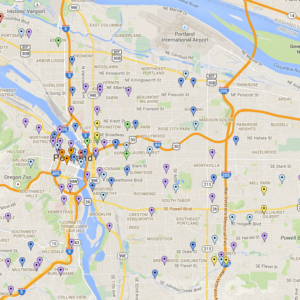
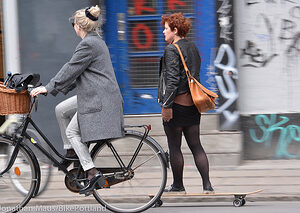

Thanks for reading.
BikePortland has served this community with independent community journalism since 2005. We rely on subscriptions from readers like you to survive. Your financial support is vital in keeping this valuable resource alive and well.
Please subscribe today to strengthen and expand our work.
I support this! It’s really cool seeing users on all sort of non-motorized transport using the greenways. I wish I skateboarded as a kid–the health benefits seem amazing.
And (pardon my ignorance if otherwise) my guess is that any surface that needs to be skateboard friendly will certainly benefit cyclists !
The BAC [Bicycle Advisory Committee] is I think limited to 20 members appointed by the transportation commissioner based upon input from city staff and the committee itself. Inner Portland tends to be vastly over-represented on that committee, so he’ll have a bit of competition getting on it. The BBAC [Bureau Budget Advisory Committee] is selected sort-of by the commissioner, but by selecting organizations rather than by selecting individuals to serve, so periodically they’ll get a member like myself (2009-15) that they clearly don’t want, but they have to accommodate anyway. I assume the PAC [Pedestrian Advisory Committee] is a bit like the BAC. Not sure how FAC [Freight Advisory Committee] members are selected.
**Note from comment moderator: I spelled out acronyms to help folks understand. Hope you don’t mind the intrusion David. – Jonathan**
I’m having difficulty following this comment due to the mess of non-explained abbreviations.
BAC = Bicycle Advisory Committee
BBAC = (Pbot) Bureau and Budget Advisory Committee
PAC = Pedestrian Advisory Committee
FAC = Freight Advisory Committee
Thank you.
Thanks the explanation helped
The BAC, PAC, and FAC primarily deal with technical issues on projects, some network policy and technical issues, and dabble in overall city transportation policies.
The BBAC deals with the nuts and bolts of the budget, not just this year’s, but also next year’s and up to five years from now, line by line, both projects and programs, so overall policies quickly come into play. It’s also the committee that does it’s best to keep PBOT from really screwing up. Unlike the other committees, PBOT staff are directly represented as employees, as well as having at least one disabled member on a mobility device. There’s a rep from the Street Trust, Oregon Walks, Columbia Corridor, PBA, TriMet, each of the 7 neighborhood district coalitions, one or two freight companies, etc, usually 19 members in all.
The BAC is so useless. It’s a bunch of well-off central city advocates meeting at 6 pm downtown on Tuesdays. Its essentially designed to cut out residents of Portlands working class neighborhoods
cmh89,
I’ve attended and taken notes at BAC meetings consistently for about 14 years or so. The BAC isn’t perfect; but they do try to find reps from every part of our city. I find your comment to be out of line with reality and way too harsh based on what I’ve seen and heard over the years.
I’ve also attended BAC meetings, when I can, they are difficult to get to considering they happen downtown at 6 pm on Tuesdays.
They might “try” to get folks from all over but the reality is that it’s a bunch of white folks from the central city who end up on the committee. Considering the central city is over-represented in every single aspect of city government, you’d think the BAC would reserve the majority of spots for people who live in under-represented and historically (and currently) neglected parts of the city.
The BAC has been totally instrumental in getting dozens of miles of unprotected gutter bike lanes built though! Truly a civic treasure.
Thanks cmh89. You make some important points. I agree the BAC could do a much better job with representation. Someone from the BAC should chime in, but my hunch is that they’ll say, “We’re limited by who applies for the seats.” Of course that is not an excuse, but to get a stronger pool of applicants would require doing the work of connecting to other parts of the community and BIPOC — both of which remain huge problems not just for the BAC but for PBOT and transportation advocates in this town more broadly.
I’m glad to have some discussion about shortcomings of the BAC. They themselves have struggled for years to find their identity and to be as effective as possible. I also know it’s very hard work and it’s all volunteer (!), so we should keep that in mind when offering criticism.
At least Portland’s BAC and PAC meets in the evening. In my community, our Bicycle and Pedestrian Advisory Committee meets at 2 pm on Fridays, in the middle of the work day, so the only people attending are either retired, unemployed or paid to be there.
The only thing bad that I can say about skating is, you need a three of shoes. Not a pair.
Those grooves and joints are necessary for outdoor concrete and for structures to be seismically sound. They are especially significant on bridges and decks because of the amount of expansion and contraction due to temperature variation in those structures. Not ideal for skateboards and scooters with small wheels.
Yes! All bridges need expansion joints. But there are easy and affordable ways to make them not terrible for skaters. For instance, the large radius joints that are often put on concrete sidewalks and MUPs are terrible to skate on. Simply putting them at a slight angle or using a saw cut can eliminate the problem. With most bridge expansion joints the problem could be solved by adjusting how much filler is installed. currently, most contractors leave a deep gap where they could just as easily fill the joint a bit more and make it a non-issue for skates. The same goes for traction grating and the use of paver stones. None of these are necessary to meet design objectives but make it difficult or impossible to skate.
I wouldn’t surprise me if some of the larger-than-needed expansion joints are problematic for people with some types of disabilities, even if they are ADA compliant (and I wouldn’t be surprised if they were not–it’s not hard to find ADA violations on any new project). For many people, smooth (but not slippery) is good. Anything than can catch a cane tip, walker leg, wheel, or toe is bad.
A lot of people want that same seat at the table for a variety of reasons and also applied when there were openings posted in January. This is not as simple as adding him to the table, as David Hampsten noted there are only 20 seats on the BAC. Who would you have sidelined in favor of having Cory at the proverbial table during this last cycle?
With 20 seats I don’t think it’s unreasonable to have a single person available to represent skate and scoot interests. How would the cycling advocates feel if there was only a freight / car advisory committee and they wouldn’t concede a single seat for all cycling interests?
We aren’t looking for a whole committee, just a single seat.
People on the BAC aren’t required to only use bikes to get around, just like the PAC isn’t required to walk everywhere and membership on the FAC isn’t tied to constant piloting of a freight vehicle to get around. There’s one member of the BAC who’s been using a scooter extensively for many months recently and others have made use of them at one time or another.
The argument I am recognizing is ironically the same one drivers use to defend not funding bike lanes because if someone is on a bike they aren’t paying for the roads. Transportation modes are fluid and for some people involve more ways of getting around than others but it’s hard to find people who uses one mode to the exclusion of all others.
Hi David. I appreciate you commenting here.
My hunch is that Cory has a unique perspective that isn’t represented on the BAC at the moment. IMO when it comes to advocacy, perspective is often THE most important thing to have. I don’t know all the other new recruits (yet), but I doubt they understand skateboarding to the extent Cory does. I think he has some legitimate beefs.
I don’t disagree that Cory has a unique perspective, or that skateboarders ought to be represented on discussions at the BAC. My question, and I suspect for PBOT as well: Does Cory directly represent a larger diverse community that he regularly communicates with, either via Twitter, Facebook, a newsletter, monthly meetings, or whatnot? If he’s simply an individual with really strong views but no base, then he’s very unlikely to be selected to take the place of an existing member or organization. But if he can prove he has a really strong following within the local skateboard community, then his chances of getting a seat at the table is a lot stronger.
“The COVID-19 pandemic has forced a massive shift in thinking when it comes to how we get around. Let’s hope that shift includes more open minds to skateboarding and small but important changes to our infrastructure that will support it.”
national gas prices at $1.77 is forcing a “massive shift in thinking” about how to get around?
i don’t see it.
I wouldn’t call it a massive shift, but I’ll bet a lot of people who depend on public transit are rethinking options.
Anyone who drives has to be loving it — gas is cheaper, roads are faster, parking more available. Everyone is talking about how few cars are out there with traffic levels just a bit over half of normal. But with everything closed and everyone trying to do things virtually, why are the numbers anywhere near that high?
Just so happens that when I was in grad school, I used to frequently use rollerblade for transport — it’s great in some developed areas if you’re only going a few miles. No way I’d do it in PDX. Not because of the expansion joints and whatnot — more because the surfaces are so bad everywhere that it would just be slow and trash the wheels.
>>> Anyone who drives has to be loving it — gas is cheaper, roads are faster, parking more available. <<<
And those using transit are hating it; not just because of fears of contamination, but also because many lines are running on reduced schedules.
Has Portland (TriMet) had any transit stoppages yet? Our drivers in Greensboro are required to answer a covid-19 questionnaire every shift start, “Do you personally know anyone who has contracted Covid-19 recently?” On Wednesday all our drivers answered “yes” when one of the drivers had to go to the hospital from it, and the operators had no choice but to shut down the whole bus service until the afternoon shift. Durham NC had to do the same thing last week. There’s no certainty the drivers got sick from a passenger – we’re doing all the right things, deep cleaning buses, fareless rear entry and exit, no passengers near the driver who has all the right masks and shields, etc. – they could have gotten it from shopping at the supermarket, a friend, a relative – but the driver’s fears are real like they are for anyone else.
With practically everything closed, people under stay at home and social distancing orders, the question is why they’re still operating.
Under normal circumstances when everyone needs them to get around, it takes very little to shut the system down — sometimes for days on end as happens with fairly modest snowstorms that I’m still able to bike through.
But now that it’s actually dangerous for operators and passengers alike, they’ve still been chugging along.
Hi The Street Trust, if you’re reading this, do you have anyone paid to advocate for the region’s carless? If so, can you/they please jump in to provide an official answer Kyle’s question? Many thanks!
understand the fear if mass transit, but taiwan is great example of how effective a simple mask is. taiwan subways were packed in early/mid feb(and i’d presume now), but everyone EVERYONE wears masks. no fear, just followed protocol.
Awesome. Thank you Cory! Various light electrics, and people who jog or run (with or without strollers and other cargo) are similar—and similarly unserved. The future is based on speed, size and mass not shape or mechanism.
I see expensive damage in public spaces, everyplace there is an edge, caused by “grinder” skateboarders. This inconsiderate and costly behavior can be filed among “that’s why we can’t have nice things” With that out of the way, I acknowledge transportation skateboarding is a different beast and a benign “last mile” option.
It is worth noting the rough texture on the green thermoplastic is for traction when the surface is wet, and smooth surfaces when wet provide little traction, compromising safety for cyclists. I suspect detectable dots at curb ramps for the sight impaired similarly annoy skate boarders. Conveyance serves many masters and I expect little sympathy by railroads, bridge designers, or pavement engineers who need to design to a price point to cater to skateboarders. However even in this article, where the wheel is nested in a bridge deck gap, the expansion joint on the sidewalk is diminished and would provide safer passage. Transportation skateboarding is a mode of transportation with 2″diameter wheels and as little as one inch of ground clearance that is used a by a fraction of one percent of the population, and those users are not just able bodied, but athletic. I appreciate that Cory is a stud and a true-believer, but even in Portland, he is the outer edge of a small demographic whose wish list will not likely be affordable and not something I would recommend over other safety measures such as pedestrian crossing enhancements. OK, start the flame fest
Cars with studded tires do more damage to public areas than skateboards. I guess the only difference is “roads were made for cars”. So, it’s okay for cars to destroy roads. But if you ever hear the sound of studded tires outside the legal dates, you should be very angry.
“You can use studded tires in Oregon from Nov. 1 to March 31. (For 2020, the removal deadline is May 1 due to the COVID-19 emergency.) Driving with studded tires before Nov. 1 or after March 31 is a Class C violation and carries a presumptive fine of nearly $200.”
https://www.oregon.gov/ODOT/Pages/winter-driving.aspx
The damage that studded tires do to road surfaces is not in any way connected to the damage skateboarders do to things with corners. I think both are bad.
Dare I touch this?
Skaters have always made use of the environment at hand. This is true of those who started riding asphalt banks in the 1970’s to those who built the Burnside Skatepark completely by hand. One of my dreams would be to integrate features into the transportation environment. If the Green loop had small bumps rails and banks more people on skates, scoots and BMX bikes would use it. At the end of the day it’s about getting people out of their cars and onto active modes. Most skaters work to protect good skate features and some forward-thinking businesses are actually integrating skate features into their plazas. Skating is a healthy accessible activity. Why wouldn’t we want to encourage it?
As for damaging private property, It’s typically in areas with no public skate infrastructure. I don’t condone it but also see it for the minimally disruptive behavior that it is.
If you added all of the damage and wear from skateboards in the entire United States I doubt it would amount to the cost of one mile of urban freeway construction.
We need to keep things in proportion here.
Firstly, BMX and other bike riders (fixed gear freestyle, urban mountain bikers etc.) cause similar damage. Generally speaking skateboarders and BMXers are only ‘grinding’ curbs, rails ledges and walls (rarely on private property). Yes, it causes minor damage but in comparison to the damage of car culture, people reinterpreting public space in a healthy creative manner should be encouraged and celebrated.
Pete, we will have to agree to disagree. You sound like your are rationalizing behavior that you know is damaging to public spaces. I recall about a year back some bicycle freestyler was using the Japanese Interment Camp Memorial as a skills park. Grinders take contemplative spaces and repurpose them for themselves to the exclusion of the public at large. You won’t see people sitting where and jelling where shredders are grinding. I don’t dispute cars and studded tires cause damage. That is not a license to cause different damage for grinding fun.
Your Contemplation is not my Contemplation, but your Contemplation is okay.
That seems a bit extreme when the subject is skateboarding in that location. I wouldn’t want to see people going to a skate park and standing contemplatively in the way of its users saying, “Your shredding is not my shredding, but your shredding is OK”.
“Yes, it causes minor damage but in comparison to the damage of car culture, people reinterpreting public space in a healthy creative manner should be encouraged and celebrated.”
Two things–one, when people are using a space in the “wrong” way, the response too often is to shut them down, instead of asking why they’re doing it, then acting. Usually the answer is because they don’t have better options. A related example is tennis courts in parks, where you see people using them to toss balls to their dogs, having their kids bike or trike in them, etc. Rather than banning all that, it could make more sense to create spaces designed for them, or allow it in some courts.
Two, the damage done trying to stop skateboarding can be worse than the skateboarding damage. An example–Parks built a bunch of new railings/handrails at a new park entrance. I never saw anyone EVER skate on the rails, but Parks added a bunch of collars every few feet to stop the hypothetical damage. The collars violate ADA standards, by making it impossible for people to continually grasp the handrails. Some are sharp. They required screwing into the handrail in a way that will let water in and fill the rails with water, eventually rusting them.
Same thing with benches in plazas that have bumps put in every few feet, making them less usable for sitting. The basic response to skateboarding too often seems to be to try to stop it (not saying it should be allowed everywhere) rather than integrate it. It’s a great, creative, healthy activity, for play or transportation.
I guess my first question (to catch up on current): are skateboards identified as an “approved” design vehicle in the relevant city and state (ODoT) design manuals and guidance…like, wheel diameter, etc…so that new facilities can take their design and operational needs/ short comings in consideration when materials and design are chosen? [Technically…skateboard design has radically evolved since I was a skateboarder using new 1970s boards and 1960s hand-me-down boards…especially now those powered units that streak past me at 20 to 30 mph on the road.]
To answer your question. Skateboards are currently not in the state vehicle code. I hope to change that soon. But it’s largely irrelevant. There is no hypothetical situation here. Skateboards are already widely used. We know the strengths and limitations of skateboards. Skateboarding is already legal in many Oregon cities and towns. I would love to geek out with you and talk about all the technical aspects of skateboard design but I won’t do it here. You can always find me on FB at The Northwest Skate Coalition.
As for the E-skates. They are still a bit of a wildcard. We are all still learning about how they will fit into our transportation infrastructure. There is certainly potential as with e-scoots.
Hi Cory Poole, here is a very simple solution to your issues with expansion joints and sidewalk cracks… wikihow.com/Ollie – A
Pretty sure Cory taught your mom to Ollie
“X”, you got me… excellent burn – A
Your mom IS cool, not everybody skates like that!
Fan of Cory P. here. Take my hypothetical seat on the BAC or whatever Cory!
I used to have some fellow feeling for motorcycle riders (similarly exposed vs. car users) but then the other day a motorcycle rider clipped a friend of mine, cracking one of their vertebra, while making a needless fast pass In A Neighborhood. Stopped and took responsibility OK, but I’m switching that fellow feeling to skaters.
People using skateboards on the street have a lot in common with bike riders. They are really similar in mass, speed, width, turning radius, etc. Skaters are hyper self- and situationally aware and their distinctive sound lets you know they are coming. It seems to me that the e-board users may be just a little over brave but anybody who is kicking a board all over town has my total respect.
Corey’s doing good work! Skaters and bikers gotta stick together!!!